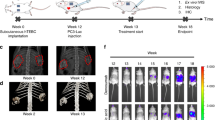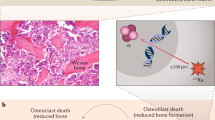Abstract
Prostate adenocarcinoma is the most common malignancy diagnosed in males, and bone metastases remain a significant source of morbidity and mortality in this population. The ubiquitin-proteasome cascade is responsible for the degradation of intracellular proteins, and this pathway is thought to play an essential role in the development of malignancies by altering the levels of various proteins involved in the regulation of cell division. Proteasome inhibitors represent a class of chemotherapeutic agents that have been shown to inhibit tumor growth by a number of different mechanisms. Using a murine intratibial injection model, we examined the effects of the proteasome inhibitor bortezomib on the establishment and progression of osteolytic bone lesions induced by human CaP cells (PC-3 cell line). In this study, the intravenous administration of bortezomib (1 mg/kg) did not prevent the initial formation of osteolytic lesions but did appear to inhibit their growth in a time-dependent fashion. In contrast, bortezomib therapy effectively inhibited the establishment and progression of subcutaneous PC-3 tumors, which served as a positive control. These results suggest that proteasome inhibitors such as bortezomib may represent a novel adjunctive therapy for the treatment of osteolytic skeletal metastases, especially when treatment is initiated early during the disease process.
This is a preview of subscription content, access via your institution
Access options
Subscribe to this journal
Receive 4 print issues and online access
$259.00 per year
only $64.75 per issue
Buy this article
- Purchase on SpringerLink
- Instant access to full article PDF
Prices may be subject to local taxes which are calculated during checkout



Similar content being viewed by others
References
Jemal A et al. Cancer statistics, 2003. CA Cancer J Clin 2003; 53: 5–26.
Koeneman K, Yeung F, Chung L . Osteomimetic properties of prostate cancer cells: a hypothesis supporting the predilection of prostate cancer metastasis and growth in the bone environment. Prostate 1999; 39: 246–261.
Glaves D . Mechanisms of metastasis: prostate cancer. Prog Clin Biol Res 1987; 239: 329–345.
Chiarodo A . National Cancer Institute round table on prostate cancer: future research directions. Cancer Res 1991; 51: 2498–2505.
Pound CR et al. Natural history of progression after PSA elevation following radical prostatectomy. JAMA 1999; 281: 1591–1597.
Coux O, Tanaka K, Goldberg AL . Structure and function of the 20S and 26S proteasomes. Annu Rev Biochem 1996; 65: 801–847.
Pickart CM . Mechanisms underlying ubiquitination. Annu Rev Biochem 2001; 70: 503–533.
Garrett IR et al. Selective inhibitors of the osteoblast proteasome stimulate bone formation in vivo and in vitro. J Clin Invest 2003; 111: 1771–1782.
Goldberg AL, Stein R, Adams J . New insights into proteasome function: from Archaebacteria to drug development. Chem Biol 1995; 2: 503–508.
King RW, Deshaies RJ, Peters JM, Kirschner MW . How proteolysis drives the cell cycle. Science 1996; 274: 1652–1659.
Hershko A . Roles of ubiquitin-mediated proteolysis in cell cycle control. Curr Opin Cell Biol 1997; 9: 788–799.
Spataro V, Norbury C, Harris AL . The ubiquitin-proteasome pathway in cancer. Br J Cancer 1998; 77: 448–455.
Adams J et al. Proteasome inhibitors: a novel class of potent and effective antitumor agents. Cancer Res 1999; 59: 2615–2622.
Sunwoo JB et al. Novel proteasome inhibitor PS-341 inhibits activation of nuclear factor-kappa B, cell survival, tumor growth, and angiogenesis in squamous cell carcinoma. Clin Cancer Res 2001; 7: 1419–1428.
Hideshima T et al. The proteasome inhibitor PS-341 inhibits growth, induces apoptosis, and overcomes drug resistance in human multiple myeloma cells. Cancer Res 2000; 61: 3071–3076.
Bours V et al. The NF-kappa B transcription factor and cancer: high expression of NF-kappa B- and I kappa B-related proteins in tumor cell lines. Biochem Pharmacol 1994; 47: 145–149.
Oikawa T et al. The proteasome is involved in angiogenesis. Biochem Biophys Res Commun 1998; 246: 243–248.
Um JH et al. Increased and correlated nuclear factor-kappa B and Ku autoantigen activities are associated with development of multidrug resistance. Oncogene 2001; 20: 6048–6056.
Nawrocki ST et al. Effects of the proteasome inhibitor PS-341 on apoptosis and angiogenesis in orthotopic human pancreatic tumor xenografts. Mol Cancer Ther 2002; 1: 1243–1253.
Kordes U et al. Transcription factor NF-kappaB is constitutively activated in acute lymphoblastic leukemia cells. Leukemia 2000; 14: 399–402.
Ni H et al. Analysis of expression of nuclear factor kappa B (NF-kappa B) in multiple myeloma: downregulation of NF-kappa B induces apoptosis. Br J Haematol 2001; 115: 279–286.
Beg AA, Baltimore D . An essential role for NF-kappaB in preventing TNF-alpha-induced cell death. Science 1996; 274: 782–784.
Wang CY, Mayo MW, Baldwin AS . TNF- and cancer therapy-induced apoptosis: potentiation by inhibition of NF-kappaB. Science 1996; 274: 784–787.
Van Antwerp DJ et al. Suppression of TNF-alpha-induced apoptosis by NF-kappaB. Science 1996; 274: 787–789.
Palombella VJ, Rando OJ, Goldberg AL, Maniatis T . The ubiquitin-proteasome pathway is required for processing the NF-kappa B1 precursor protein and the activation of NF-kappa B. Cell 1994; 78: 773–785.
Cusack JC, Liu R, Baldwin AS . NF-kappa B and chemoresistance: potentiation of cancer drugs via inhibition of NF-kappa B. Drug Resist Updat 1999; 2: 271–273.
Delic J et al. The proteasome inhibitor lactacystin induces apoptosis and sensitizes chemo- and radioresistant human chronic lymphocytic leukaemia lymphocytes to TNF-alpha-initiated apoptosis. Br J Cancer 1998; 77: 1103–1107.
Cusack Jr JC et al. Enhanced chemosensitivity to CPT-11 with proteasome inhibitor PS-341: implications for systemic nuclear factor-kappaB inhibition. Cancer Res 2001; 61: 3535–3540.
Soligo D et al. The apoptogenic response of human myeloid leukaemia cell lines and of normal and malignant haematopoietic progenitor cells to the proteasome inhibitor PSI. Br J Hematol 2001; 113: 126–135.
Russo SM et al. Enhancement of radiosensitivity by proteasome inhibition: implications for a role of NF-kappaB. Int J Radiat Oncol Biol Phys 2001; 50: 183–193.
Ma MH et al. The proteasome inhibitor PS-341 markedly enhances the sensitivity of multiple myeloma tumor cells to chemotherapeutic agents. Clin Cancer Res 2003; 9: 1136–1144.
An B, Goldfarb RH, Siman R, Dou QP . Novel dipeptidyl proteasome inhibitors overcome Bcl-2 protective function and selectively accumulate the cyclin-dependent kinase inhibitor p27 and induce apoptosis in transformed, but not normal, human fibroblasts. Cell Death Differ 1998; 5: 1062–1075.
Frankel A et al. Lack of multicellular drug resistance observed in human ovarian and prostate carcinoma treated with the proteasome inhibitor PS-341. Clin Cancer Res 2000; 6: 3071–3076.
Orlowski RZ et al. Phase I trial of the proteasome inhibitor PS-341 in patients with refractory hematologic malignancies. J Clin Oncol 2002; 20: 4420–4427.
Aghajanian C et al. A phase I trial of the novel proteasome inhibitor PS341 in advanced solid tumor malignancies. Clin Cancer Res 2002; 8: 2505–2511.
Davis NB et al. Phase II trial of PS-341 in patients with renal cell cancer: a University of Chicago phase II consortium study. J Clin Oncol 2004; 22: 115–119.
Richardson PG et al. A phase 2 study of bortezomib in relapsed, refractory myeloma. N Engl J Med 2003; 348: 2609–2617.
Kane RC, Bross PF, Farrell AT, Pazdur R . Velcade: U.S. FDA approval for the treatment of multiple myeloma progressing on prior therapy. Oncologist 2003; 8: 508–513.
Papandreou CN et al. Phase I trial with proteasome inhibitor bortezomib in patients with advanced solid tumors with observations in androgen-independent prostate cancer. J Clin Oncol 2004; 22: 2108–2121.
Williams S et al. Differential effects of the proteasome inhibitor bortezomib on apoptosis and angiogenesis in human prostate tumor xenografts. Mol Cancer Ther 2003; 2: 835–843.
Lin HK et al. Proteasome activity is required for androgen receptor transcriptional activity via regulation of androgen receptor nuclear translocation and interaction with coregulators in prostate cancer cells. J Biol Chem 2002; 277: 36570–36576.
Kaighn M et al. Establishment and characterization of a human prostate carcinoma cell line (PC-3). Invest Urol 1979; 17: 16–23.
Craft N et al. Evidence for clonal outgrowth of androgen-independent prostate cancer cells from androgen-dependent tumors through a two-step process. Cancer Res 1999; 59: 5030–5036.
Lee Y et al. Use of zoledronate to treat osteoblastic vs osteolytic lesions in a severe-combined-immunodeficient mouse model. Cancer Res 2002; 62: 5564–5570.
Lee Y et al. Differences in the cytokine profiles associated with prostate cancer cell induced osteoblastic and osteolytic lesions in bone. J Orthop Res 2003; 21: 62–72.
Landis JR, Koch GG . The measurement of observer agreement for categorical data. Biometrics 1977; 33: 159–174.
Zhang J et al. Osteoprotegerin inhibits prostate cancer-induced osteoclastogenesis and prevents prostate tumor growth in the bone. J Clin Invest 2001; 107: 1235–1244.
Yonou H et al. Osteoprotegerin/osteoclastogenesis inhibitory factor decreases human prostate cancer burden in human adult bone implanted into nonobese diabetic/severe combined immunodeficient mice. Cancer Res 2003; 63: 2096–2102.
Whang PG et al. The effects of RANK blockade and osteoclast depletion in a model of pure osteoblastic prostate cancer metastasis in bone. J Orthop Res 2005; July 5 (Epub ahead of print).
Major PP, Lipton A, Berenson J, Hortobagyi G . Oral bisphosphonates: a review of clinical use in patients with bone metastases. Cancer 2000; 88: 6–14.
Acknowledgements
This study was supported by a research grant from the National Institutes of Health (R-01 CA-103039:01 (JRL)) and CaPCURE (JRL). We also thank Millennium Pharmaceuticals Inc., for generously providing the bortezomib used in this study as well as Fred Dorey, PhD, for his assistance with the statistical analyses.
Author information
Authors and Affiliations
Corresponding author
Rights and permissions
About this article
Cite this article
Whang, P., Gamradt, S., Gates, J. et al. Effects of the proteasome inhibitor bortezomib on osteolytic human prostate cancer cell metastases. Prostate Cancer Prostatic Dis 8, 327–334 (2005). https://doi.org/10.1038/sj.pcan.4500823
Received:
Revised:
Accepted:
Published:
Issue Date:
DOI: https://doi.org/10.1038/sj.pcan.4500823
Keywords
This article is cited by
-
The Proteasome and Myeloma-Associated Bone Disease
Calcified Tissue International (2018)



